Our Wild Malygos Druid deck list guide for the Kobolds and Catacombs expansion, will teach you the ins-and-outs of this combo deck! This Malygos Druid guide includes Card Choices, Mulligans, Gameplay Strategy, and Card Substitutions!
Introduction to Wild Malygos Druid
Malygos Druid is a deck with a long history in Hearthstone. In seasons now long past, Miracle Druid capitalized on Gadgetzan Auctioneer to cycle cards before utilizing the Aspect of Magic to close out games with a massive amount burst.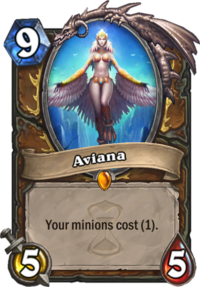
Since the release of Mean Streets of Gadgetzan, however, the interaction between Kun the Forgotten King and Aviana essentially grants Druids an extra turn. Thanks to these two class Legendaries, along with rampant mana acceleration and powerful card draw engines, Druids can consistently land a Malygos-enabled OTK.
Kobolds and Catacombs
With Kobolds and Catacombs came the addition of Ixlid, Fungal Lord who offers the potential to summon as many as four Malygos. This absurd amount of Spell Damage can easily kill opponents from the highest of life totals in a single turn.
Perhaps more importantly, the latest expansion provided Druid with potent additional armor generation tools. These new defense options ensure Malygos Druid survives long enough to assemble the combo pieces necessary to close games. Branching Paths and Oaken Summons, especially, make it easy to accumulate ridiculous amounts of armor for opponents to chew through.
Wild Malygos Druid Card Choices
The individual cards in Wild Malygos Druid can be sorted into the following categories: Mana Ramp, Defensive Tools, Card Cycle, Combo Pieces, and Damage Spells. Thanks to the flexibility of the Druid class, a handful of cards in Wild Malygos Druid fall into more than one of these groups.
Mana Ramp
One of Druid’s core mechanics is ramping mana crystals. In this deck, the more you’re able to ramp in the early turns, the sooner you’ll be able to cast Ultimate Infestation and draw into your combo pieces.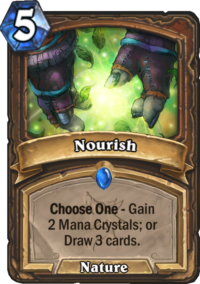
- Wild Growth – The bread and butter of Druid mana ramp, Wild Growth is a mainstay in nearly any late-game oriented Druid deck.
- Nourish – Nourish pulls double duty as both a ramp spell and card cycle. Typically, your first Nourish will be spent accumulating additional mana crystals.
Defensive Tools
Against aggressive decks, the game plan is more about surviving the onslaught of damage than it is about pulling off the combo as soon as possible. Fortunately, Malfurion has several defensive tools available to bide enough time to close out games against the most relentless aggro decks.
- Lesser Jasper Spellstone – At one mana, Lesser Jasper Spellstone can efficiently clean up minions without any upgrades. With as many armor gain cards as Wild Malygos Druid has, however, you’ll be surprised by how quickly it’ll be able to deal six to priority-kill minions.
- Ironwood Golem – Ironwood Golem provides a reliable Taunt minion to stifle pressure in the early turns. The drawback for this card is largely irrelevant thanks to the Malygos Druid’s lack of dependence on minion damage and the numerous armor gain tools available in the deck.
- Branching Paths – The option to gain 12 armor for four mana effectively makes Branching Paths a better Greater Healing Potion. The armor gain from this card alone is enough to stabilize against many decks.
- Oaken Summons – Gaining six armor for four mana isn’t terribly exciting. Doing so while Recruiting an Ironwood Golem into play, however, makes Oaken Summons worth a spot in this deck.
- Swipe – Druid is notoriously light on area of effect removal. As such, early Swipes are often best used to clean up a wide board.
- Poison Seeds – In the Wild format, several decks (namely Big Priest and Giants Warlock) are capable of establishing a daunting board state. Poison Seeds is Druid’s best option as a reset button to buy some time against these increasingly popular decks.
- Spreading Plague – Few cards punish opponents for overextending on the board quite as much as Spreading Plague. Against many aggro decks, Spreading Plague can buy your face as many as two full turns before minions are again able to reach it.
- Malfurion the Pestilent – In slower Druid decks, Malfurion the Pestilent can provide a lot of value over the course of the game. Armoring up can pull you out of lethal range and the three attack can clear important minions.
Card Cycle
As is often the case in Combo decks, digging through your deck to find the cards to kill your opponent is critical. Thanks to the potency of Druid’s cycle cards, relatively few card slots need to be dedicated to this purpose.
- Branching Paths – In slower matchups, the ability to cycle once or twice with Branching Paths can be the difference between a win and a loss. The flexibility of this card makes it well worth a spot in this deck.
- Nourish – While the first Nourish is frequently used for mana ramp, in later turns, drawing three cards can be enough to find the last few pieces to score a kill.
- Ultimate Infestation – Ultimate Infestation is a card that can just about do it all. It’s got Armor Gain, removal potential, and a chance at swinging the board. In this deck, however, drawing five cards digs deep into your deck to find those precious combo pieces.
Combo Pieces
A combo deck is nothing without combo pieces. Wild Malygos Druid leans heavily on the interaction between Aviana and Kun the Forgotten King to generate an extra turn’s worth of mana. Fortunately, unlike Exodia, this deck doesn’t always require all five pieces to end the game. Often, a mere Malygos or two will suffice.
- Ixlid, Fungal Lord – What’s better than one Malygos? That’s right, four. While not always necessary to score a kill, Ixlid makes it possible to turn humble Moonfires into 21-damage bombs.
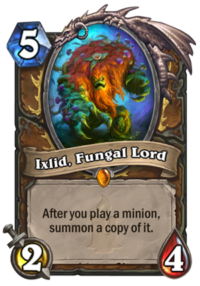
- Faceless Manipulator – In most games, double Malygos is enough to finish off an opponent. A such, Faceless Manipulator helps
- Aviana – Part one of Druid’s dynamic duo, Aviana makes it possible to play and copy Malygos while still having enough mana available to cast burn spells.
- Kun the Forgotten King – The second half of
- Malygos – The final piece to the puzzle, even a single Malygos turns your damage spells into potent burst damage. Even when paying the full mana cost of Malygos, you can drop 19 damage on your opponent in the same turn.
Damage Spells
Finally, Damage Spells are included to nuke opposing players once the combo is assembled. Wild Malygos Druid runs a total of six spells that can be played on the same turn as the combo but, given the amount of Spell Damage that is possible, rarely are more than a few needed. As such, half (or more) of these spells can be used for removal in the early turns.
- Moonfire – Moonfires can do substantial amounts of damage with enough Spell Damage, all at the cost of zero mana.
- Living Roots – Like Moonfire, Living Roots offers finishing potential at a low cost once the combo is assembled. The extra damage can often be used to efficiently clean early game minions.
- Swipe – Swipe is a potent clear on its own and absolutely decimates a board with even one Malygos in play. The latter fact becomes highly relevant in situations where you need two turns to finish a game.
Wild Malygos Druid Mulligan Strategy & Guide
Depending on the matchup, Wild Malygos Druid has very different mulligan strategies. Against aggressive decks, defensive tools must be prioritized. When facing slower-developing decks, you can safely search for mana ramp and card cycle.
The diversity of the Wild metagame provides all classes with multiple viable archetypes. If you’re uncertain about what deck your opponent is playing, it’s often better to err on the side of caution and mulligan for aggro.
VS Fast Decks
Higher Priority (Keep every time)
- Lesser Jasper Spellstone – Early turns are spent removing minions against aggressive decks. Lesser Jasper Spellstone does great work to this end and offers the potential to scale up in the late game.
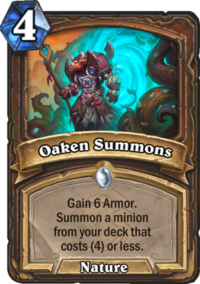
- Living Roots – Like Lesser Jasper Spellstone, Living Roots can easily deal with important minions in the early turns.
- Wild Growth – Many of the defensive tools that lock out the game cost six or more mana. Wild Growth helps makes those critical cards castable sooner.
- Oaken Summons – Gaining armor is obviously beneficial against fast decks, but cheating a Taunt minion into play at the same time makes Oaken Summons the perfect anti-aggro keep.
Lower Priority (Keep only if certain conditions are met)
- Spreading Plague – It may seem greedy to hold onto a six mana card, but Spreading Plague’s ability to shut down aggression makes it reasonable to keep against board-centric decks.
- Branching Paths – Branching Paths can quickly pull you out of range of your opponent’s burst potential. That said, unlike Oaken Summons, it doesn’t do anything to manage the board state. As such, it’s not as good of a turn four play.
- Nourish – Wild Malygos Druid is a deck with a lot of high-cost cards. Even against faster decks, getting to the top end of your mana curve is necessary. No card helps you get there faster than Nourish.
- Swipe – Decks that go wide on the board often leave themselves susceptible to Swipe. In these matchups, keeping this card can make a significant difference.
- Malfurion the Pestilent – Again, the mana cost of this card may give you a bit of hesitation. However, the immediate impact Malfurion has against aggro coupled with the persistent armor gain makes it worth a keep in certain matchups.
VS Slow Decks
Higher Priority (Keep every time)
- Wild Growth – When matched against other slow decks, early turn Wild Growths can give you a lead going into the late game.
- Oaken Summons – Oaken Summons effectively functions as card cycle, pulling an Ironwood Golem from your deck directly into play.
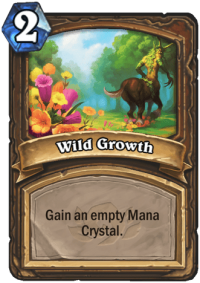
- Nourish – The importance of mana ramp in these matchups cannot be overstated. Even at five mana, Nourish can give you the head start necessary to get a back-breaking early Ultimate Infestation.
Lower Priority (Keep only if certain conditions are met)
- Poison Seeds – One of Malfurion’s greatest weaknesses is difficulty in dealing with a board full of minions. In a format where Naga Sea Witch + Giants decks and Big Priest run rampant, Poison Seeds can neutralize some of the overwhelming board states these decks present.
- Branching Paths – The flexibility of this card makes it at least worth considering in nearly any matchup. Against slower, control decks the ability to cycle cards to dig for the tools you need is always helpful.
- Malfurion the Pestilent – Time is frequently on your side against other slow decks. Malfurion the Pestilent can generate enough armor to provide you with more time to assemble your combo.
- Ultimate Infestation – Ultimate Infestation is such a powerful card that, in slower matchups, it often feels like the outcome is determined by how early the card is cast. With mana ramp already in hand, keeping this ten-mana card isn’t ridiculous.
Wild Malygos Druid Play Strategy
The gameplay strategy for Wild Malygos Druid depends heavily on the opponent you’re facing. Against aggressive decks, your game plan is one of attrition. Here, you want to grind away at the opponent’s resources. When matched against slower decks, you have the luxury of time to ramp mana and draw into your game-ending combo.
VS Aggro Decks
Often, Wild Aggro decks are capable of quicker lethal than their Standard counterparts. To live through this onslaught, you’ll need to seek out defensive tools early on to prevent too much repetitive minion damage.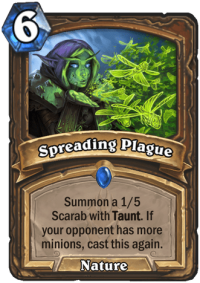
A wide, token-based board can be managed fairly easily with Spreading Plague. A handful of large minions can be more problematic, however. In these situations, upgraded Lesser Jasper Spellstones may help, but Poison Seeds may be necessary to avoid being overrun.
Against decks that run significant amounts of burn spell, avoid dipping too low in life. Use armor gain when possible to pull yourself out of burst range. Here, Branching Paths, Oaken Summons, and Malfurion the Pestilent all do significant work to keep you in the game.
Your win condition against aggro rarely involves pulling off the combo. As such, don’t be afraid to through damage spells at minions to reduce the board pressure. Most often, you want to slowly grind your opponent out of resources and present them with an insurmountable life total. From there, you can chip away at their health before bringing them down with a more abbreviated version of the combo.
VS Control Decks
Against Control decks, your game plan shifts significantly. In these matchups, you typically have the time to mana ramp and draw into your combo. Here, you’re looking to get your mana acceleration rolling in the early turns in order to out-scale your opponent’s mid to late game.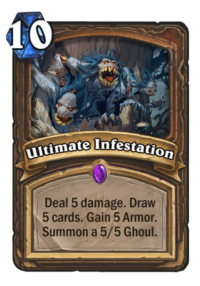
To that end, Wild Growth and Nourish become crucial. Finding these are early as possible makes an Ultimate Infestation turn available far sooner than should be possible.
At times, however, UI can be a bit of a liability. In slower matchups, you simply cannot afford to lose one of the combo pieces required to kill your opponent. Occasionally, this means dumping cards before you hit ten mana, even if it means getting little value from them. Spreading Plague spawns many scarabs in these matchups, anyway, so it’s often a good candidate to throw away. Similarly, if you already have an Ultimate Infestation in hand, Branching Paths can be used to generate armor, even if you don’t necessarily need it.
Don’t be afraid to be patient in these matchups. Unless you’re staring down another combo deck, you should have plenty of time to work towards your OTK while safely dealing with threats and accumulating armor.
Wild Malygos Druid Card General Tips
A deck with as much depth as Wild Malygos Druid requires a pilot that is capable of quickly adjusting to different situations within a game. The tips provided below can help prepare you for the different circumstances that present themselves when playing this deck.
Surviving Aggro
Against aggressive decks, your gameplan is fairly straightforward: survive. Frequently, this means sacrificing values and throwing damage spells at minions in the early turns.
Perhaps the one exception to this rule is Spreading Plague. Timing this spell correctly is absolutely crucial as it determines just how much damage it soaks up, so eking as much value out of it as possible is usually to your benefit. For six mana, you can frequently stop as 25 damage or more with a well-timed Plague. Sometimes, eating 15-20 points of damage is worth giving your opponent another turn to overextend.
In these matchups, Branching Paths is best used to accumulate massive amounts of armor. Similarly, an early Malfurion the Pestilent can lock out the game thanks to the ability to generate three armor each turn.
Managing Cards in Hand
Burning cards in most decks isn’t frequently a big concern. In a combo deck such as Wild Malygos Druid, however, losing a single combo piece can be a disaster. As such, managing the size of your hand is crucial, especially against other slower developing decks.Ultimate Infestation is typically the biggest offender in this regard. As soon as you draw the card, start mapping on how and when you can empty your hand enough to cast the 10-mana spell. Occasionally, this means dumping Wild Growth on nine mana or throwing away Moonfires or Lesser Jasper Spellstones at low-value targets. Generally speaking, you’re safe to cast Ultimate Infestation when you have five cards in hand (or six if you have a Moonfire to pitch away).
With all combo pieces already in your hand, however, burning cards should not be much of a concern.
Pulling Off the Combo
Once you have the requisite combo pieces, the sequencing of play for these cards is important. To achieve the maximum amount of Spell Damage, play your combo minions in the following order:
With this full combo in play, you can typically kill opponents with one or two Damage Spells. With 4 Malygos on the board, the damage dealt by each spell is provided below:
- Moonfire 21 Damage
- Living Roots 22 Damage
- Swipe 24 Damage
The full combo requires three mana after resetting your mana crystals with Kun the Forgotten King. As such, you cannot cast two Swipes with the full combo. If these are your two remaining damage spells, you can forgo either the Ixlid or Faceless Manipulator for 28 damage, four more than a full-combo Swipe would produce.
Often, assembling the full combo isn’t necessary to end the game. Make sure you’re spending time on your opponent’s turn paying close attention to you and counting the damage you have available.
Counting Damage
With the potential to have so much Spell Damage in play with this deck, counting damage can be a headache. To account for this, the formula below helps simplify the process of checking for lethal.
5 x Number of Malygos in Play x Number of Damage Spells + Base Damage of Spells
For example, with the full combo on board along with one Swipe and two Living Roots in hand, the amount of damage available would be:
5 x 4 Malygos x 3 Spells + (4 + 2 + 2) = 68 damage
Remember to account for Malfurion the Pestilent’s hero power in your calculations if you’ve already transformed into a Death Knight.
Playing with the Cards in Your Deck
In some situations, you may have guaranteed lethal without the requisite combo pieces or damage spells in hand. Since the full combo leaves you with seven mana available, you can often use Nourish to draw into the last card you need. By the time your combo is available, your deck is typically quite thin so be aware of which cards remain in your deck and whether or not you’re certain to draw into one that ends the game.
Wild Malygos Druid Card Substitutions
Clocking in at well over 10k Arcane Dust, Wild Malygos Druid is not exactly budget-friendly. Unfortunately, many of the Legendaries serve a unique purpose that cannot be replicated. As such, there is simply no replacement in this deck for Aviana, Kun the Forgotten King, or Malygos. That said, the Legendary and Epic cards listed below have some potential substitutions to reduce the cost of the deck. While less optimal, the deck can survive with the substitutions below.
Legendary Cards
- Ixlid, Fungal Lord – Having four Malygos in play is undoubtedly fun, but not necessary to kill most opponents. Instead, Alexstrasza or a second Faceless Manipulator can fill the void left by an absent Fungal Lord.
- Malfurion the Pestilent – In slower Druid decks, Malfurion is hard to directly replace. Additional survivability, such as Wrath, Feral Rage, and Starfall can provide a temporary replacement for the Death Knight.
Epic Cards
- Branching Paths – Branching Paths gives you options. In a slow-developing deck, having multiple options in a single card is highly valuable. Feral Rage offers similar flexibility and can be used if you’re lacking this Epic.
- Ultimate Infestation – Without UI, you’re going to need to lean heavily on Nourish for card draw. To account for this, you can include additional ramp in Greedy Sprite or Jade Blossom.

















/rating_1_half.png)
/rating_2_off.png)
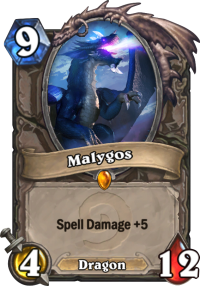
I just hit legend with a bit modified version of this deck. I used Kripp version as a basis ( http://www.hearthstonetopdecks.com/decks/kripps-wild-legend-malygos-druid-january-2018/ ) but cut 1xUltimate Infestation (I feel like I can never use two in one game and increasing odds to draw one definitely isn’t worth because it sometimes creates a situation where I sit with 2 UIs and most of combo pieces in hand and I have to throw away defensive tools to get my card slots empty just to be punished for it next turn) and 1xWrath for 2xFerocious Howl, which is a very smooth cycle and also boosts your survivability.
Great deck really, I like it a lot and it is somehow similar to my favourite Exodia Mage (which was killed by last standard rotation, that’s why I decided to move to wild and try out this deck). However, I’m struggling to find a way to win versus a tempo secret mage. With the ridiculous amount of burn it has (a total of above 30 damage), strong early game and draw, I just can’t preserve a life-total high enough to survive and I can’t rely on combo because explosive runes deny my Aviana.
Is there anything I’m missing?
Often, I prioritize armor gain from Branching Paths against Mage. This helps pull you out of range of their burn. Likewise, an early Malfurion can make the difference in the game. I keep him in my opener against mage. Finally, ensure that your armor gain doesn’t get countered. Sometimes this means throwing away spells (including ramp) to make sure your life total is protected.
Thank you for your reply! I’ll try my best to use your advice, hope it gives me some chance in this matchup. I also wanted to ask, what is my main win condition versus tempo mage? Do I try to disable all explosive runes (with ironwood golems or Ixlid) and then play combo or do I just throw Malygos/Kun and maybe copy them with manipulator next turn to try to kill him through board?
Frequently, your win condition depends on the game state. It’s important to be flexible in how you approach the matchup because so many of the Secrets can be difficult to navigate.
If they equip Aluneth or you aren’t able to bait out the Potion of Polymorphs/Explosive Runes with less critical minions, I typically shift into full turtle mode and try to tank up out of range of burn. Here, your win condition is simply fatiguing the opponent.
Similarly, if they begin to stall out and/or you stablize, you can go for the tempo Malygos play. Often, they won’t be able to remove him and you can score the kill. If they do kill him off, that’s 12 damage that isn’t going to your face.
I see, fatiguing someone who draws four cards per turn shouldn’t be that hard. Thank you very much for your help! Your advices already carried me to rank 5 and I hope this season I’ll reach my first legend.
I regularly find my hand full 7-10 cards while missing combo pieces, but with UI’s in hand, so I cant actually dig without burning cards. Am I doing something wrong or is this just a super common occurrence?
Hi, I completely agree with you: I feel like 2 UI’s are massive overkill because they often end up as an unplayable card in your hand.
I simply replaced 1 UI by 1 Wrath and had much better results with it. Also, it gives you an extra tool against aggro, extra card draw and a way to trigger Counterspell.
Another greedy solution could be to use Prince 3. 🙂
Roffle, do you have any links to VODS of you playing this deck?
I was wondering if Wild Malygos is tier 1 after the nerf- it certainly seems like it, but I’m not sure, and if i’m gonna s’end 10K dust I want to know! Its excelent against Cubelock and Big Priest, but im not sure how good it is against Giantslock or secret mage. Any tips?
I played this deck in wild in jan and can say that it’s a really strong deck against both aggro and control. it does well against aggro decks with oaken summons, plague and paths (secret and tempo mages) and control (mostly cubelock, giants lock) with seeds.
And I agree with what they said where counting damage is super important. Sometimes you dont need the combo and just drop maly and moon fire x2 and roots their face.
@Danteh It is a tier 1 deck, I can testify that as I’ve reached legend rank 36 with it from rank 8 in wild. Basically against burn mage, you just have to look for defensive cards (oaken summons, wrath, swipe, malfurion, spreading plague). As for giantslock, look for poison seeds and armour, and try not to damage your opponent’s face to prevent from reducing the cost of molten giant. Also against both of these decks, try your best to have an early ui to draw the combo